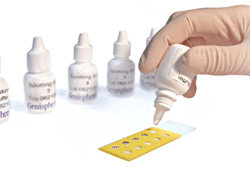My Cart
Your Shopping Cart is currently empty. Use Quick Order or Search to quickly add items to your order!
A. Malcolm Campbell, Ph.D.
Professor of Biology
Director, James G. Martin Genomics Program
Davidson College
Founding Director of GCAT

DNA microarray analysis is one of the most exciting and powerful new
methods in genomics. It allows investigators to simultaneously measure the expression level of every gene in a genome. Wouldn’t it be
great to introduce high school and college students to this exciting new method? Unfortunately, most budgets for high school and
introductory college biology classes cannot accommodate the expensive equipment and reagents needed to teach and perform DNA microarray
analysis.
What if we could affordably engage students in a similar, but simplified version of DNA microarray analysis? Not only would they learn
about a new and powerful genomics method, it would also help them learn basic and applied biology by having them perform their own
hands-on experiments. Even better, what if those experiments could help students see how math actually helps them understand biology and
that it has a role in medical diagnosis?
My collaborators, who include educators and industry researchers, and I have developed
DNA Chips: Genes to Disease, an
affordable new kit enabling you and your students to learn about DNA microarray analysis without expensive equipment and chemicals.
A hot-water bath is the only special equipment required. This kit is a great tool for engaging students in a hands-on activity that
helps them learn basic and applied biology. It can also be used to help students see the important, real-life applications of math in
biology.
DNA Chips: Genes to Disease is a 3- to 4-day module that has engaged high school and college students as described and published in the
open-access journal CBE—Life Sciences Education (Campbell et al., 2006). Day 1 begins with several different animations
(Campbell, 2001; Microarrays MediaBook) that help students understand the methodology, some background reading, and a worksheet.
Day 2 focuses on a paper lab where students apply what they learned from the animations by working with large paper representations of
DNA microarrays. On day 3, students work with the simple, inexpensive wet-lab simulations to print and develop their own DNA microarrays. They then interpret the simulated microarrays to analyze the difference in gene expression between cancerous and
noncancerous lung tissue. Day 4 (optional) can be used to teach students how to utilize math to further analyze the results. This helps
them understand how DNA microarray data are analyzed to make diagnoses and how this new technology is leading to medical breakthroughs.
The math module is posted online (Heyer and Campbell, 2008).
We have demonstrated that students in grades 10–12 using this kit experienced learning gains and positive attitudinal improvements
(Campbell et al., 2006); college students have also benefited from the kit (data unpublished). The concept of microarrays and their use
integrates many different areas of science typically covered in a biology curriculum, including genetics/heredity, cell biology,
DNA/biotechnology, technology and society, mathematics, and computer science.
In addition to content knowledge, the science skills addressed in the kit activities include applying scientific knowledge, analyzing
and interpreting data to solve problems, working together in a group with a common goal, and communication skills. Extension activities
could include ethical debates on the use of microarray data. These concepts are the framework of most state science content standards
and can be aligned to the 1996 National Science Education Standards (NSES) for Science Content developed by the National Research
Council (see below).
DNA Chips: Genes to Disease is reasonably priced and comes with 10 slides (2 students typically share a slide) and
enough reagents to easily perform the wet lab twice using the same 10 slides. Thus, even on a low budget, you can engage your students
and improve their understanding of cutting-edge genomics and biotechnology, as well as have an effective tool for teaching them the
importance and significance of math in real-life biological applications.
Campbell, A. Malcolm, Carolyn A. Zanta, Laurie J. Heyer, Ben Kittinger, Kathleen M. Gabric, and Leslie Adler.
DNA Microarray Wet Lab Simulation Brings Genomics into the High School Curriculum.
CBE—Life Sciences Education Vol. 5, 332–339,
Winter 2006.
Campbell, A. Malcolm.
DNA Microarray Methodology.
2001. Accessed 29 February, 2008.
Campbell, A. Malcolm.
DNA Microarrays Simulation.
2006. Accessed 28 February, 2008.
Genome Consortium for Active Teaching (GCAT). Accessed 28 February, 2008.
Microarrays MediaBook.
2005. Accessed 29 February, 2008.
Heyer, Laurie J. and Campbell, A. Malcolm.
Value Added: Blending Math into a High School Genomics Lab. Accessed 28 February, 2008.